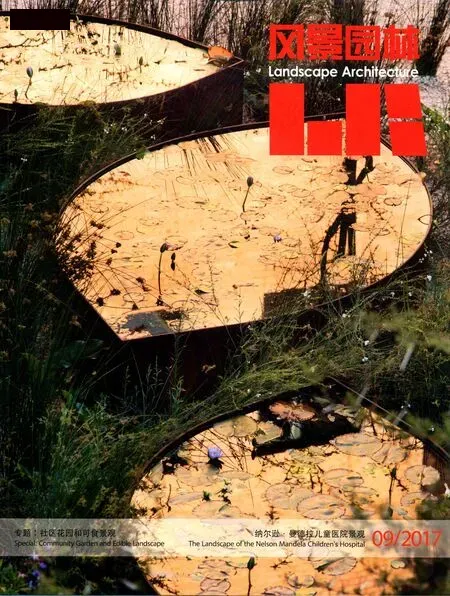波兰什切青市国家博物馆交流中心
KWKPromes 建筑事务所
波兰什切青市国家博物馆交流中心
KWKPromes 建筑事务所
历史及空间环境
什切青市(Szczecin)是波兰历史上遭受暴力事件最多的城市之一。1945年以前该市属德国,之后突然被划归波兰。短时间内的人口迁移摧毁了原有的社会结构,改变了城市的原有特征。如今的团结广场(Solidarno ci Square)在战前曾是城市的中心舞台,陈列着具有代表性的住宅,广场北侧被音乐厅所围合。联军的炸弹袭击摧毁了城区及其周边区域,形成了城市肌理中的一道裂缝。此外,城市的碎片地带还被一条交通路线所割裂。1970年,该广场变成了工人抗议运动的集会场所,在镇压过程中,16名抗议者被残忍地杀害。从那时起,这个场地就被赋予了为自由而战的象征意义。
多年以来,团结广场一直是一个徒有虚名的场地——它有着模糊的边界,开敞的临街立面和喧嚣繁忙的街区,尽管占据核心区位,却缺少功能定位——为纪念1970年12月发生的历史事件,2005年在此处修建了一座纪念碑。在21世纪,这个区域成为了建筑运动的革命场。2014年,先前的音乐厅被巴罗奇·韦加工作室(Estudio Barozzi Veiga)设计的交响会场所取代。该建筑作为什切青市的新地标,于2015年荣获密斯·凡德罗奖(Mies van der Rohe award)。
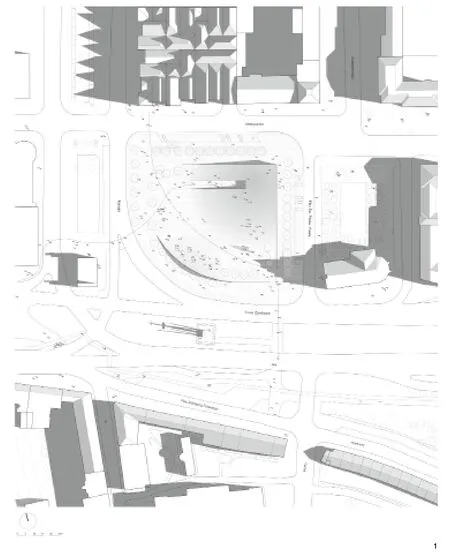
1 平面图:从图中可以看出在教堂与音乐厅之间被保留下来的交流路径Site plan: the drawing shows communication route, preserved between church and philharmonic hall
接下来的计划是新建国家博物馆“突破(Przełomy)”交流中心,设计着眼于什切青市的城市历史,改变场地的空间感受。博物馆的设计在尊重场地历史的同时,将附近的城市新地标纳入考虑范围,由此催生了设计构思:将博物馆安置在地下,创造一个作为背景的建筑物。
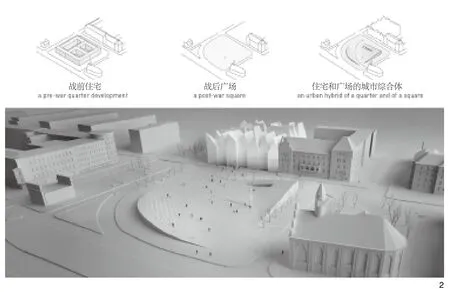
2 一个建筑将二战前的城市居住区与战后的广场这两个互相矛盾的历史联系在一起,成为一个城市混合体的塑造——将这片空间围合成一个住区,同时保留了开放空间的价值A building is bringing together two contradictory traditions — pre-war urban quarter and post-war square. That is how an urban hybrid was created—it encloses the space as a quarter, keeping the values of an open public space
概念——城市混合功能型建筑
不管是街区还是广场,它们作为设计的出发点,体现着场地上两个矛盾的传统。城市混合功能型建筑的设计既将这块区域围合起来形成一个街区,同时也保留了其公共开放空间的功能。广场上平坦的部分作为交响会场和教堂的前景,广场的地面在两个对角处被抬升,一处作为博物馆基础设施,另一处形成人造山丘,以围合城市内部空间,隔绝街道的喧嚣吵闹。而建筑与城市之间不存在明确定义的边界。
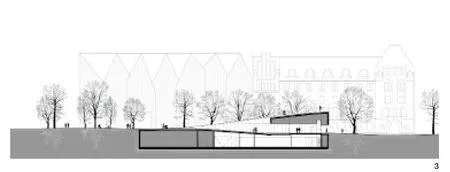
3 音乐厅方向的剖面图Section with the view on philharmonic hall

4 教堂方向的剖面图Section with the view of the church
建筑物——结构与机制(可移动的墙体)
由于建筑依附地形而建,因此博物馆在形式上作为广场混凝土地面的延续,覆以长方形的瓦片。在被抬起的一角,这些瓦片聚集在一起构成了三维的体块。当博物馆开放时,整个庞大的建筑体系就会改变其形态:一些建筑立面上的板块开始旋转,形成通向两个入口的廊道;顺应广场曲率而形成的下挖坡道成为博物馆的第3个入口。建筑的地面层作为广场的延伸,具有入口门厅的作用。
展览——以艺术的方式讲述历史
展览空间藏于地下。当人们走下楼梯,来到混凝土砖块的尽头,仿佛身处一片黑暗之中,这里展示着自二战以来什切青市的历史,讲述着当时发生在波兰的历史事件及其与世界的联系。在展览历史的同时,基于纯粹的信息,通过艺术家的杰作,设计添加了一条叙事结构,包括博物馆开幕前的作品,以及专为此场地的创作。此举使展览变得更丰富广泛,受众更普遍。展览中黑暗的环境让人集中注意力于展览的内容,创新的展示手法将这个普通的历史博物馆变成了一个艺术博物馆。
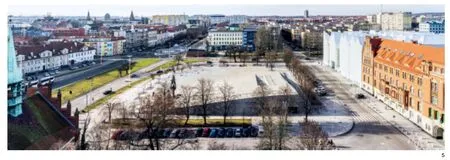
5 底下藏有博物馆的被抬起的一侧This is the view from the uplifted corner with the museum inside
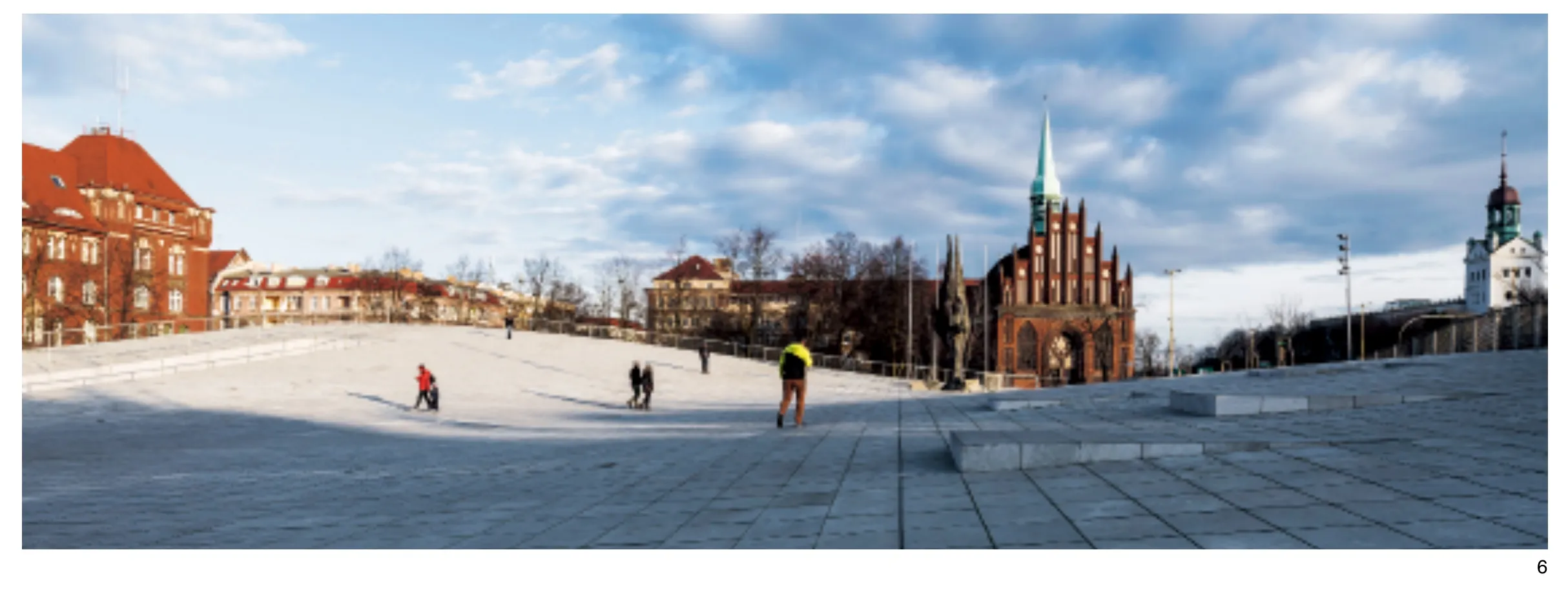
6 音乐厅与教堂前的前景Foregrounds were created in front of the philharmonic hall and the church
广场—地形引导了社会的交流与互动
从前,广场仅作为纪念历史的场所,而重建工作的开展使得它对于居民来说开始变得具有吸引力,同时鼓励着人们更好地使用它。人造山丘为人们提供了探索城市的新视角,迎接着前来徒步旅行、享受日光浴的人们。倾斜的地面激发了多种多样的活动:对于滑板爱好者来说,这是一个理想的训练场,冬天,广场可以作为雪橇的滑行轨道。同时,广场也保留着它原先的象征意义——每年举办庆典活动的时候,纪念碑都能吸引许多老兵,尽管这不作为广场的主要用途。如今,这片区域已经成为一个让各个年龄段使用者和不同社会群体共存的友好型城市空间。
(编辑/刘蓝蓝)
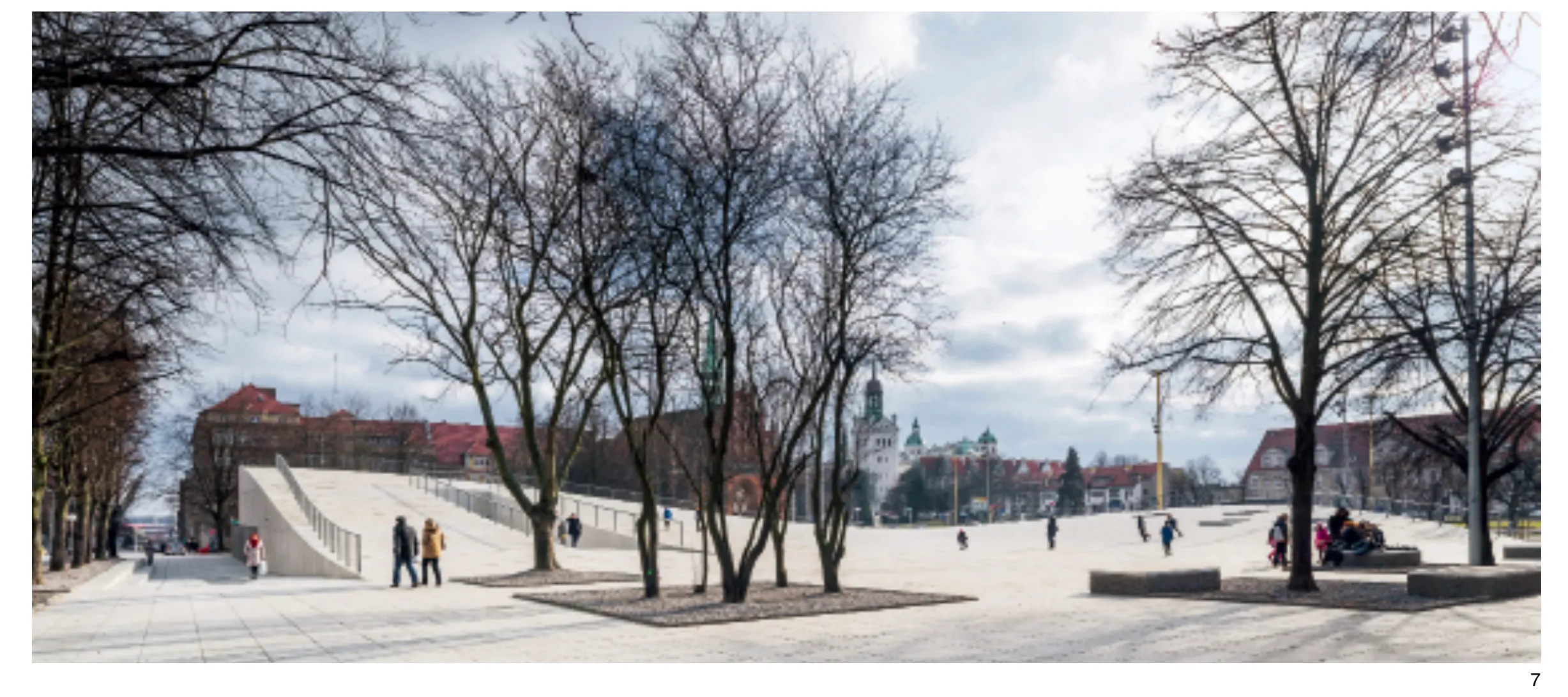
7 从音乐厅的一侧看这块场地,我们可以看到右侧山丘将广场与街道交通隔离开,左侧博物馆隐藏在广场抬起的一角下面。广场与边角处均有进入博物馆的入口Looking from the side of the Philharmonic Hall on the right, we can see a hill, that separates the square from the street traffic, on the left there is smoothly uplifted corner with the museum hidden inside. Entrance from the square as well as from the corner are leading to the museum
设计单位:KWK Promes建筑事务所,建筑师罗伯特·科尼采尼,米歇尔·利辛斯基,多萝·祖克,卡塔日娜·弗鲁卡林斯卡
合作者:建筑师亚历克桑德拉·斯托尔卡,皮厄特勒·托卡斯基,亚当·拉德齐姆斯基,乔安娜·彼得纳,马格达莱娜·亚当卡扎克
总承包商:斯堪斯卡公司
投资方:什切青市国家博物馆
场地面积:9577m2
建筑占地面积:1628m2
可用楼层面积:2117m2
展览面积:960m2
容积:15845m3
竞赛时间:2009年
项目时间:2010—2011年
建造时间:2012年1月—2016年2月
翻译:陈雨茜
校对:张希

8 由于地形的存在,建筑屋面上吸引了各种各样活动的发生,例如骑行、轮滑,甚至是在冬天滑雪橇,因为这是城市中唯一的一块山丘Due to its topography, the building is also a place for such activities as riding on the bike, skating or, during the winter, riding on a sledge, cause it is the only one hill in the city

9 人们可以从广场以及边角两处入口进入博物馆,事实上,整个屋面都是广场的延续,是一个巨大的入口空间。有趣的是当博物馆关闭时,广场上的入口变得更加醒目,因为它的存在似乎打断了广场整体的结构,而角落的建筑则像一块单一的墙体It's possible to enter the museum from both sides: square's and corner's because actually the whole ground floor is an extension of the square and one big entrance zone. What's interesting is that once the museum is closed the entrance from the side of the square is more pointed out because it's a cut in its structure while the corner seems to be a monolithic wall
Historical and Spacial Context
Szczecin is one of the largest victims of historical violence in Poland. Until 1945, the city lay within the borders of Germany, after which it was suddenly incorporated into Poland.Instant exchange of its population deconstructed the social fabric and distorted the city’s identity.Before the war, the current Solidarności Square was the showcase of the city, featuring a quarter of representative tenements, enclosed by the Konzerthaus in the North. During bombing raids of the Allied forces the quarter and its vicinity ceased to exist, creating a gap in the urban tissue.Furthermore, this fragment of the city was cut through by a transportation route. This quasisquare became the arena for worker protest in 1970, which was brutally paci fi ed, and 16 protesters were killed. From that moment on, this place became a symbol of fi ght for freedom.
For years, the Solidarności Square had been a square by name only — with vague borders, open frontages, burdensome busy street neighborhood and the absence of a de fi ned function, despite the dominating one — to commemorate the events of December 1970, where the place was provided a monument in 2005. In the 21st century, the area became the arena of significant architectural interventions. In 2014, the former Konzerthaus was replaced by a new philharmonic venue designed by Estudio Barozzi Veiga. The building became the new city icon, winning the main Mies van der Rohe award in 2015.
The next initiative, which contributed to changing the perception of the space was the National Museum’s Dialogue Centre “Przełomy”,devoted to the history of Szczecin. When designing the Museum we set our mind humble to the history of the place and the new city icon closeby. Thus,the idea to hide the museum underground to create a background architecture.Idea—Urban Hybrid
Two contradictory traditions: of a quarter and of a square were the point of departure for the design, an urban design hybrid which encloses the space as a quarter, while retaining the values of open public space. The flattened areas of the square create foregrounds in front of the philharmonic and the church. The quarter forms in oposite corners as elevated square fl oor. The one elevation houses the museum facillity, the other one is an arti fi cial hill, closing up the urban interior and shielding it from the tumult of the busy street.There is no de fi nite boundary between architecture and ubanism.
Building—Structure and Mechanisms(Movable Walls)
The architecture follows topography, hence the museum’s form is a continuation of the concrete fl oor of the square which is covered with rectangular tiles. In the elevated corner these tiles gain 3rd dimension, becoming cuboidal blocks. The whole makes a monolith that transforms when the museum opens. Some of the vertical plates rotate,thus creating the arcades unveiling two entrances.The third entrance is determined by a ramp carved in the square’s curvature. Ground fl oor is a square’s extension and it functions as an entrance hall.
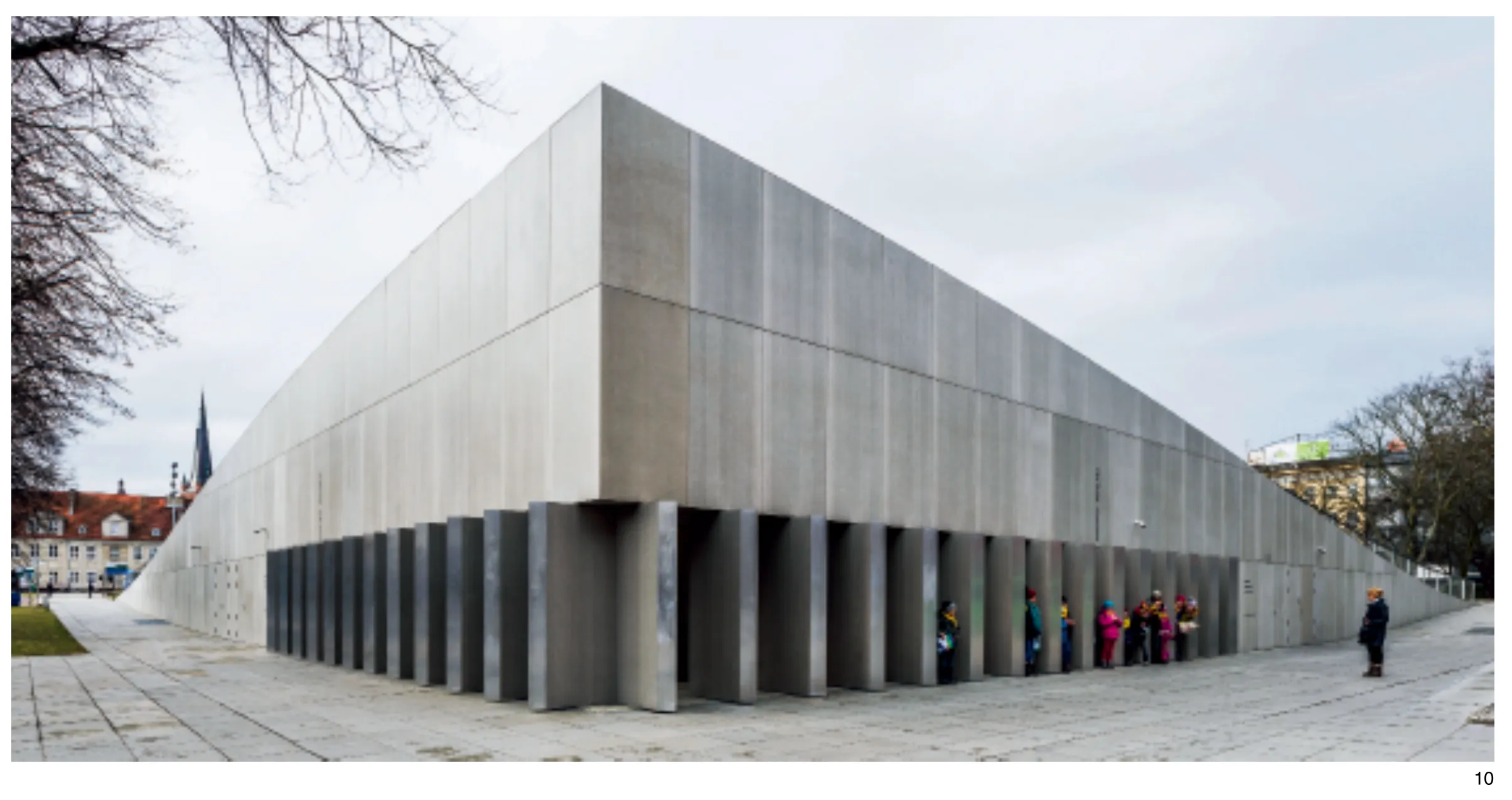
10 博物馆的入口藏在可移动、可旋转的墙体中,吸引了许多学校前来参观Entrances to the museum are hidden behind the movable, rotating walls, which, as you can see, are the attraction for the school trip
Exhibition—History Told with Art
The exhibition space is hidden underground.When we go down the stairs the concrete ends and we submerge in blackness that is a background for the tale of Szczecin since the II world war, in a connection of what was happening in Poland and the rest of the world. Simultaneously with the historic exhibition, based on pure information, we add a narration spinned by artists’ masterpieces —both, the works from long before the museum was opened, and the ones intentionally created for this venue. This kind of attempt allowed the exhibition to become wider and more universal. The blackness allows to focus on presented objects while giving the impression of an infinite space. This brand new formula for the exhibition makes a historical museum an art museum as well.
Square—Topography Encouraging Social Interactions
Before, the square was only to commemorate the history — as a result of redevelopment this part of the city became attractive for the other(remaining) habitants. Yet, its open formula encourages its users to express their impact.Artificial hills provide an opportunity for discovering new outlooks on the city, welcome walking tours and invite to sunbathing. The slanted fl oor inspires various activities: for skateboarders,this is the ideal spot to practice. In the winter, the square serves as a sled track. The yard has retained its symbolic dimension — the monument is still attracting veterans during annual celebration events— it is not dominating aspect after all. Today, this urban space is a place of amicable coexistenceof different age and societal groups.
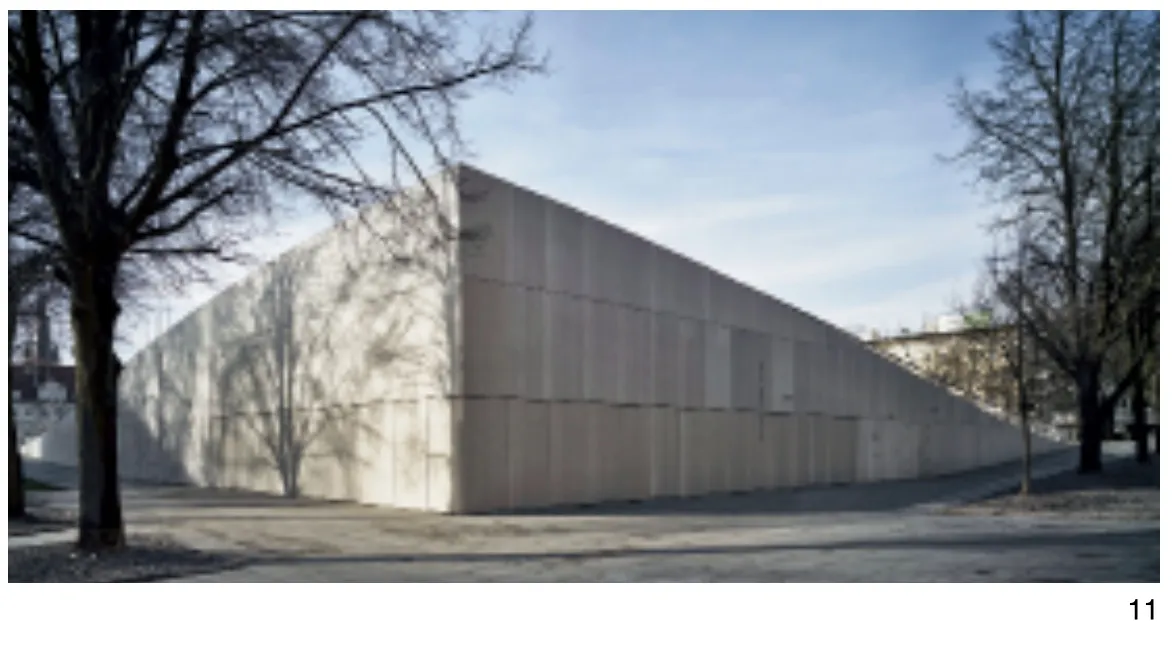
11 门关闭后,我们能感受到建筑巨大、单一的体量After closing, we are getting the impression of monolith
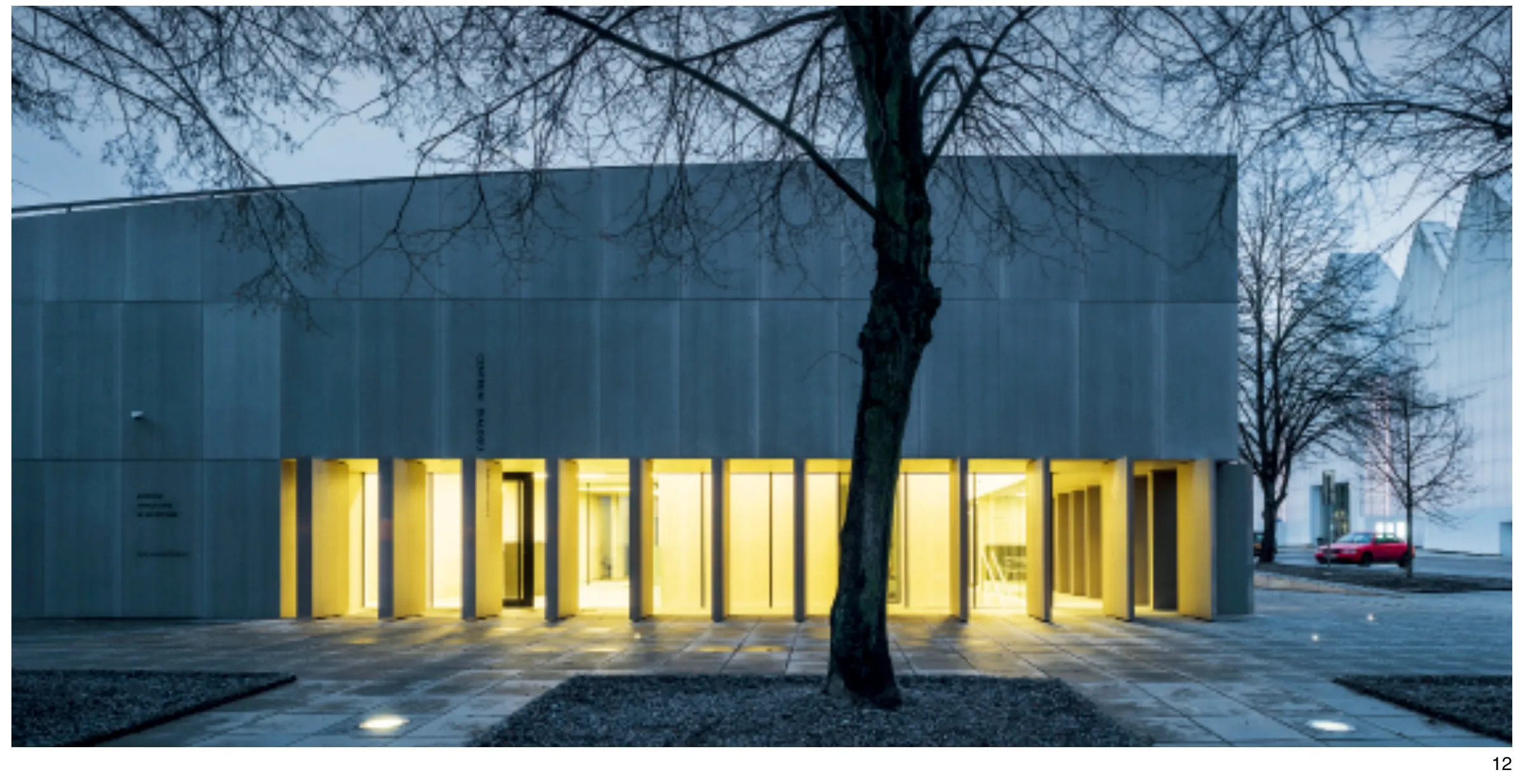
12 当建筑开启时,部分墙体垂直于建筑立面。从一侧观赏建筑,你仅仅能感受到一个强调入口的巨大的单一体。只有正对着建筑立面站立,你才能发现墙后装有玻璃的内部空间Once the buildingis open the walls are brought into a position perpendicular to the elevation.Viewing the building from anangle, especially viewing the corner, you get an impression of a monolith, only with more emphasized entrance. Not until you stand perpendicularly to the elevation you notice that there is a glazed interior hidden behind the walls

13 为了建筑的纯净与统一感,所以所有的出入口都是相同的。它们隐藏在可移动、可旋转的墙体中,线型上延续了广场的铺装We cared about the building's purity and homogeneity so all entrances and exits are equivalent. From bothsides, they are hidden behind moveable, rotatable walls continuing squares labs' divisions
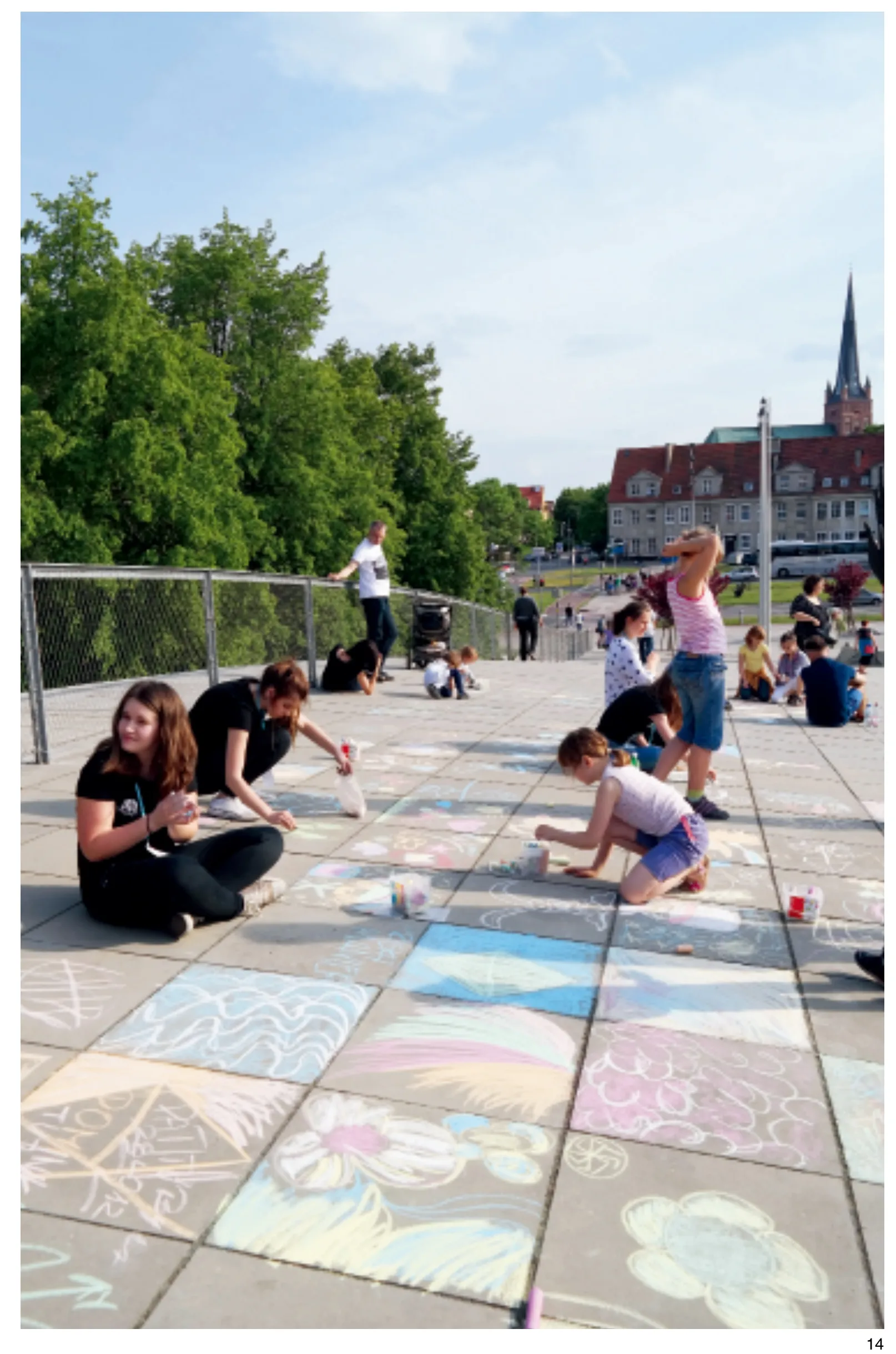
14 有时候建筑的屋顶变成一块巨大的黑板,孩子们在上面留下彩色的图画Sometimes the roof of the building turns to be a huge blackboard on which children left some colorful ornaments
Authors of the square: KWK Promes, architects Robert Konieczny, Michał Lisinski
Authors of the competition entrance:
Robert Konieczny, Dorota Zurek, Katarzyna Furgalinska
Collaboration: architects Aleksandra Stolecka, Piotr Tokarski,Adam Radzimski, Joanna Biedna, Magdalena Adamczak
General contractor: Skanska
Investor: National Museum in Szczecin (Muzeum Narodowe w Szczecinie)
Site area: 9577 m2
Gross covered area: 1628 m2
Usable floor area: 2117 m2
Exhibition surface: 960 m2
Volume: 15845 m3
Competition: 2009
Project: 2010—2011
Construction: January 2012—February 2016
Translator: CHEN Yu-xi
Proofreader: ZHANG Xi
National Museum in Szczecin Dialogue Centre Przelomy
KWKPromes

